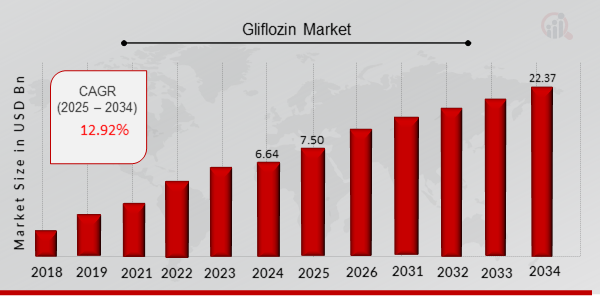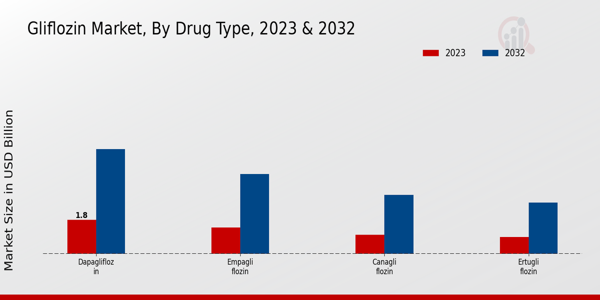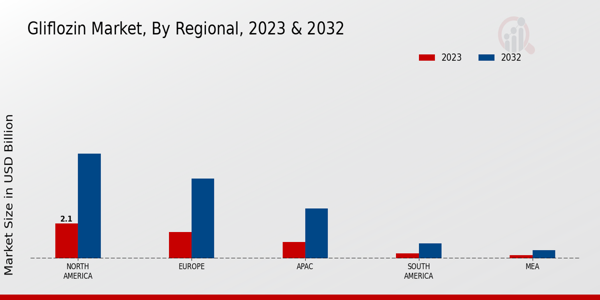Gliflozin Market Overview
As per MRFR analysis, the Gliflozin Market Size was estimated at 6.64 (USD Billion) in 2024. The Gliflozin Market Industry is expected to grow from 7.50 (USD Billion) in 2025 to 22.37 (USD Billion) till 2034, at a CAGR (growth rate) is expected to be around 12.92% during the forecast period (2025 - 2034).
Key Gliflozin Market Trends Highlighted
The Gliflozin Market is witnessing significant growth driven by the increasing prevalence of diabetes and the rising awareness of the benefits of SGLT2 inhibitors. As healthcare systems focus on improving patient outcomes, gliflozins are gaining traction due to their effectiveness in lowering blood sugar levels and offering additional benefits like weight loss and cardiovascular protection. Furthermore, advancements in research and development are leading to new formulations and combination therapies, enhancing the appeal of these medications. Growing investments in healthcare infrastructure and digital health solutions also contribute to the market's expansion.Opportunities in this sector are abundant, especially in emerging markets where the prevalence of diabetes is on the rise. Increased focus on preventive healthcare and early diagnosis provides a platform for gliflozin products. Collaborations between pharmaceutical companies and research institutions can accelerate innovation and widen the therapeutic uses of gliflozins. Education and outreach initiatives are essential to inform healthcare providers and patients about these medications, thereby increasing adoption rates. As new clinical studies continue to emerge, demonstrating the broader health benefits of gliflozins, manufacturers have a chance to strengthen their market position.Recent trends indicate a shift towards personalized medicine, with healthcare providers increasingly focusing on tailoring diabetes management strategies to individual patient needs. The integration of technology, such as mobile health applications for monitoring diabetes, is playing a key role in patient management and adherence. Additionally, there is an increasing emphasis on sustainability, prompting pharmaceutical companies to explore eco-friendly manufacturing practices. Overall, the market is transitioning towards a more holistic approach, emphasizing patient-centric care and innovative solutions in diabetes treatment.

Source: Primary Research, Secondary Research, MRFR Database and Analyst Review
Gliflozin Market Drivers
Rising Prevalence of Diabetes
The Gliflozin Market Industry is experiencing significant growth driven by the increasing prevalence of diabetes globally. With the World Health Organization reporting a substantial rise in diabetes cases, particularly type 2 diabetes, there is a growing demand for effective treatment options. Gliflozins, as a class of medications known for their role in managing blood sugar levels, have gained attention for their beneficial properties beyond glucose control, including weight loss and improved cardiovascular outcomes.These factors make gliflozins a critical component in diabetes management protocols. The ongoing shift towards preventive healthcare and the emphasis on diabetes control among public health initiatives are further fuelling the demand for gliflozins in treatment regimens. As healthcare providers increasingly recognize the advantages offered by gliflozin medications, including their safety profiles and additional health benefits, the adoption rate is likely to rise in the coming years.This trend sets a promising landscape for growth within the Gliflozin Market Industry, making it an urgent area of focus for pharmaceutical companies aiming to innovate and expand their product lines, catering to the needs of a growing patient population.
Advancements in Drug Formulations
Ongoing advancements in drug formulations are another pivotal driver of the Gliflozin Market Industry. Innovations in the delivery methods of gliflozins, including improved oral formulations and combinations with other antihyperglycemic agents, enhance patient adherence to prescribed therapies. This trend not only ensures better management of diabetes but also optimizes treatment outcomes, fostering a more robust market. As pharmaceutical companies continue to invest in research and development, new formulations are likely to emerge, expanding the applications and effectiveness of gliflozins in diabetes care.
Favorable Regulatory Environment
The favorable regulatory environment surrounding the approval and commercialization of gliflozins significantly bolsters the Gliflozin Market Industry. Regulatory bodies are increasingly focused on expediting the approval processes for new medications that offer innovative solutions for chronic diseases such as diabetes. This trend encourages pharmaceutical companies to invest in the research and development of new gliflozin therapies, fostering a competitive marketplace.As the regulatory landscape continues to evolve in support of advancing healthcare solutions, the Gliflozin Market is likely to benefit from accelerated product introductions and enhanced market access.
Gliflozin Market Segment Insights:
Gliflozin Market Drug Type Insights
The Gliflozin Market revenue is showing promising trends as it expands within the Drug Type segment, which plays a crucial role in addressing various diabetes-related health issues. By 2023, the market valuation reached 5.2 USD Billion and is projected to grow significantly to 15.5 USD Billion by 2032, reflecting a growing demand for effective diabetes medications. Among the key players in this segment, Dapagliflozin stands out with a valuation of 1.8 USD Billion in 2023, expected to rise to 5.5 USD Billion by 2032, indicating its strong acceptance and effectiveness in managing blood glucose levels and providing added cardiovascular benefits. This positions Dapagliflozin as a majority holding within the market, appealing to both healthcare providers and patients. Similarly, Empagliflozin demonstrates significant market traction with a valuation of 1.4 USD Billion in 2023, which is anticipated to grow to 4.2 USD Billion by 2032, suggesting that its benefits in reducing the risk of cardiovascular disease in diabetic patients make it an important choice. Canagliflozin, although smaller in market size, still holds a notable position with a valuation of 1.0 USD Billion in 2023, expected to expand to 3.1 USD Billion by 2032, supporting its role in providing effective glycemic control. Ertugliflozin holds the smallest share within the Drug Type segment at a value of 0.9 USD Billion in 2023, projected to increase to 2.7 USD Billion by 2032. Despite its comparatively lower valuation, Ertugliflozin's market presence indicates its targeted approach in specific patient populations, contributing to ongoing options within diabetes management. Collectively, the Gliflozin Market segmentation highlights a diversification of therapeutic agents that cater to different patient needs and preferences, bolstered by ongoing clinical research and development efforts. These growth drivers, such as the increasing prevalence of diabetes, an aging population, and rising awareness about the disease, are paving the way for opportunities in this market, while challenges remain, including regulatory barriers and competition from other therapeutic classes. Overall, the significance of the Drug Type segment is evident from the distinct positions held by Dapagliflozin, Empagliflozin, Canagliflozin, and Ertugliflozin, each contributing to the overall progress and evolution of the Gliflozin Market industry. The Gliflozin Market data reflects an increasingly competitive landscape where innovations and patient-oriented solutions will drive future developments and market growth.

Source: Primary Research, Secondary Research, MRFR Database and Analyst Review
Gliflozin Market Indication Insights
The Gliflozin Market, valued at 5.2 billion USD in 2023, showcases a robust growth pattern driven by increased awareness and demand for effective treatments for various health conditions such as Type 2 Diabetes, Heart Failure, and Chronic Kidney Disease. The segment of Type 2 Diabetes stands out significantly, as gliflozins have become a cornerstone in managing blood glucose levels in patients, leading to their widespread adoption. Heart Failure is increasingly recognized for its growing prevalence, positioning it as another essential area where gliflozins are making a substantial impact.The importance of managing Chronic Kidney Disease cannot be overlooked, as gliflozins have shown promising benefits in slowing the progression of this condition, thereby catering to a vital need in patient care. With the Gliflozin Market projected to reach 15.5 billion USD by 2032, market growth is underpinned by advancements in clinical research and the introduction of innovative therapies, along with increasing healthcare expenditure. However, the industry faces challenges such as stringent regulatory requirements and market competition which may affect growth dynamics going forward.Overall, ongoing research and development in gliflozin therapies represent opportunities that are anticipated to further stimulate the market.
Gliflozin Market Administration Route Insights
The Administration Route segment of the Gliflozin Market demonstrates significant growth, contributing to an overall market value of 5.2 USD billion in 2023. By 2032, the market is poised for a substantial increase as it is projected to reach 15.5 USD billion. This segment is crucial as various administration routes cater to different patient needs and preferences, ensuring better treatment adherence and outcomes. Among these, the oral route dominates due to its ease of use and convenience, making it a preferred choice for patients managing diabetes.
Likewise, the intravenous route plays a pivotal role, particularly in hospital settings, allowing for rapid drug delivery and optimal therapeutic effects. Market data shows that the rise in diabetes prevalence and the increasing demand for effective glucose-lowering therapies drive the growth of the Gliflozin Market. However, challenges including potential side effects and the requirement of patient education remain, presenting both hurdles and opportunities for growth in this segment. As the industry evolves, continued innovation in drug formulations and delivery mechanisms is expected to shape the market landscape further.
Gliflozin Market Distribution Channel Insights
The Gliflozin Market revenue has been on a consistent upward trajectory, showing substantial potential in various distribution channels. In 2023, the overall market value reached 5.2 billion USD, showcasing the growing acceptance and demand for Gliflozin products. The distribution channels primarily encompass Hospital Pharmacies, Retail Pharmacies, and Online Pharmacies, each playing a significant role in the market's expansion. Hospital Pharmacies are vital as they serve both inpatients and outpatients, helping in the effective management of diabetic patients through integrated healthcare approaches.Retail Pharmacies hold a crucial position as they provide easy accessibility of Gliflozin medications to the general public, catering to the growing population afflicted by diabetes. Recently, Online Pharmacies have gained importance, especially in light of increased digitalization and consumer preference for home delivery services, therefore enhancing market reach. This growing trend towards online distribution channels is driven by convenience and a need for discreet purchases, thus representing a major opportunity within the Gliflozin Market industry.With the market growth trajectory pointing towards 15.5 billion USD by 2032, these distribution channels are poised to play an essential role in meeting the evolving needs of patients and healthcare providers alike, as reflected in the Gliflozin Market statistics.
Gliflozin Market Regional Insights
The Gliflozin Market is showing significant growth potential across various regions, with the overall market valued at 5.2 USD Billion in 2023 and projected to reach 15.5 USD Billion by 2032. North America dominates this landscape, with a valuation of 2.1 USD Billion in 2023, reflecting a strong demand driven by rising diabetes prevalence and advanced healthcare infrastructure. Europe follows closely, holding a valuation of 1.6 USD Billion in the same year, benefiting from comprehensive healthcare policies and increased awareness about diabetic treatment.The APAC region, valued at 1.0 USD Billion, is emerging as a significant player due to its large population and increasing healthcare investments. Meanwhile, South America and the MEA regions are on the lower end, valued at 0.3 USD Billion and 0.2 USD Billion respectively, highlighting potential growth opportunities in these emerging markets. The majority holding of North America in the Gliflozin Market suggests its pivotal role in contributing to market trends, driven by innovation and consumer behavior shifts towards diabetes management solutions.

Source: Primary Research, Secondary Research, MRFR Database and Analyst Review
Gliflozin Market Key Players and Competitive Insights:
The Gliflozin Market has witnessed significant transformations over the past few years, driven by a combination of factors including increasing prevalence of diabetes, rising awareness among healthcare professionals and patients, and ongoing advancements in pharmaceutical research and development. As more players enter the market and existing companies innovate, the competitive landscape continues to evolve. This competitive environment is characterized by strategic collaborations, aggressive marketing strategies, and a focus on the development of novel formulations to enhance therapeutic outcomes. The emergence of biosimilars and generics is also reshaping competition, adding pressure on pricing and market share dynamics. As a result, understanding the competitive insights within this market is essential for stakeholders looking to navigate the complexities of gliflozin products.Kadmon has established a noteworthy position within the Gliflozin Market, focusing on the development of unique therapeutic approaches aimed at enhancing treatment efficacy. The company's strengths lie in its robust research capabilities, which facilitate the discovery of innovative gliflozin formulations designed to meet the diverse needs of patients with diabetes. Additionally, Kadmon's commitment to clinical trials and thorough regulatory compliance reinforces its credibility and reputation in the market. The strategic partnerships and collaborations that Kadmon has forged with academic institutions and industry leaders further bolster its position, enabling it to leverage cutting-edge research and technology. This collaborative approach enhances their capabilities to bring new products to market effectively. Furthermore, Kadmon's investment in patient outreach and education helps establish strong brand loyalty and trust among caregivers and patients alike.Pfizer stands out as a formidable player within the Gliflozin Market, primarily due to its extensive experience in pharmaceutical research and its diverse portfolio of diabetes treatments. The company's strong financial foundation allows it to invest heavily in the development and marketing of gliflozin products, positioning it favorably against competitors. Pfizer's established global presence enables it to access multiple markets efficiently, thus broadening its outreach and increasing market penetration. Additionally, Pfizer's focus on innovative drug development, combined with its robust pipeline, ensures that it remains at the forefront of diabetes care solutions. The company's commitment to ongoing research and development, alongside strategic collaborations with healthcare organizations, enhances its ability to deliver effective treatment options. Pfizer's emphasis on patient-centric initiatives supports its market position by fostering trust and satisfaction among healthcare providers and patients, ultimately contributing to its competitiveness in the gliflozin market.
Key Companies in the Gliflozin Market Include:
- Kadmon
- Pfizer
- Roche
- Eli Lilly
- Takeda
- Bristol Myers Squibb
- Johnson and Johnson
- AstraZeneca
- Amgen
- Merck
- Teva
- GSK
- Novartis
- Sanofi
- Boehringer Ingelheim
Gliflozin Market Industry Developments
Recent developments in the Gliflozin Market have showcased notable activities, particularly focusing on major players like Pfizer, Eli Lilly, and AstraZeneca. Pfizer is advancing its research on gliflozins to improve diabetes management, while Eli Lilly has been enhancing its portfolio with innovative solutions for diabetic patients. AstraZeneca has recently made significant strides in expanding its market share by launching new clinical trials aimed at understanding the long-term effects of gliflozin medications. Additionally, there has been a growing interest in mergers and acquisitions within this market. Companies like Roche and Bristol Myers Squibb are exploring strategic partnerships to bolster their gliflozin offerings and expand their market reach. Recent shifts in market valuation indicate a positive growth trajectory for companies such as Takeda and Novartis, which are expected to have a substantial impact on gliflozin sales and overall market dynamics. Furthermore, the increased focus on diabetes care is propelling the demand for these medications, with organizations like Boehringer Ingelheim and Merck also ramping up their research efforts to enhance product efficacy and patient outcomes.
Gliflozin Market Segmentation Insights
- Gliflozin Market Drug Type Outlook
- Dapagliflozin
- Empagliflozin
- Canagliflozin
- Ertugliflozin
- Gliflozin Market Indication Outlook
- Type 2 Diabetes
- Heart Failure
- Chronic Kidney Disease
- Gliflozin Market Administration Route Outlook
- Gliflozin Market Distribution Channel Outlook
- Hospital Pharmacies
- Retail Pharmacies
- Online Pharmacies
- Gliflozin Market Regional Outlook
- North America
- Europe
- South America
- Asia Pacific
- Middle East and Africa
| Report Attribute/Metric |
Details |
|
Market Size 2024
|
6.64 (USD Billion)
|
|
Market Size 2025
|
7.50 (USD Billion)
|
|
Market Size 2034
|
22.37 (USD Billion)
|
|
Compound Annual Growth Rate (CAGR)
|
12.92 % (2025 - 2034)
|
|
Report Coverage
|
Revenue Forecast, Competitive Landscape, Growth Factors, and Trends
|
|
Base Year
|
2024
|
|
Market Forecast Period
|
2025 - 2034
|
|
Historical Data
|
2020 - 2024
|
| Market Forecast Units |
USD Billion |
| Key Companies Profiled |
Kadmon, Pfizer, Roche, Eli Lilly, Takeda, Bristol Myers Squibb, Johnson and Johnson, AstraZeneca, Amgen, Merck, Teva, GSK, Novartis, Sanofi, Boehringer Ingelheim |
| Segments Covered |
Drug Type, Indication, Administration Route, Distribution Channel, Regional |
| Key Market Opportunities |
Increasing diabetes prevalence, Expanding global awareness, Innovative combination therapies, Growing demand for personalized medicine, Emerging markets expansion |
| Key Market Dynamics |
increasing prevalence of diabetes, growing geriatric population, rising healthcare expenditure, advancements in drug development, rising awareness of treatment options |
| Countries Covered |
North America, Europe, APAC, South America, MEA |
Frequently Asked Questions (FAQ) :
The Gliflozin Market is expected to be valued at 22.37 USD Billion by 2034.
The projected CAGR for the Gliflozin Market from 2024 to 2034 is 12.9%.
North America is expected to dominate the Gliflozin Market with a projected value of 6.3 USD Billion by 2032.
The market value of Dapagliflozin in 2023 was 1.8 USD Billion.
Major players like Pfizer and Roche are expected to maintain significant shares in the Gliflozin Market.
The market value of Empagliflozin is projected to reach 4.2 USD Billion by 2032.
The Gliflozin Market is valued at 1.0 USD Billion in the APAC region for 2023.
The expected market value for Canagliflozin by 2032 is 3.1 USD Billion.
There are significant growth opportunities in the Gliflozin Market due to increasing diabetes prevalence and innovative treatments.
The market value for Gliflozin in South America is expected to reach 0.9 USD Billion by 2032.

















